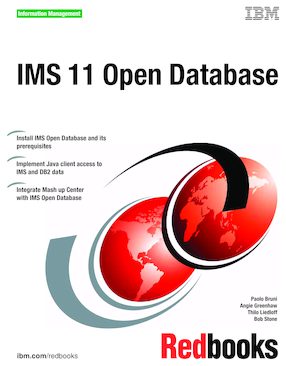IMS 11 Open Database
An IBM Redbooks publication
Note: This is publication is now archived. For reference only.

Published on 10 August 2010, updated 12 August 2010
ISBN-10: 0738434566
ISBN-13: 9780738434568
IBM Form #: SG24-7856-00
Authors: Paolo Bruni, Angie Greenhaw, Thilo Liedloff and Bob Stone
IMS™ Version 11 continues to provide the leadership in performance, reliability, and security that is expected from the product of choice for critical online operational applications. IMS 11 also offers new functions to help you keep pace with the evolving IT industry.
Through the introduction of the new IMS Enterprise Suite application developers with minimal knowledge of IMS Connect can start developing client applications to communicate with IMS.
With Open Database, IMS 11 also provides direct SQL access to IMS data from programs that run on any distributed platform, unlocking DL/I data to the world of SQL application programmers.
In this IBM® Redbooks® publication, system programmers get the steps for installing the new IMS components, and the application programmer can follow scenarios of how client applications can take advantage of SQL to access IMS data.
We describe the installation of prerequisites, such as IMS Connect and the Structured Call Interface component of Common Service Layer address space and document the set up of the three new IMS drivers:
- Universal DB resource adapter
- Universal JDBC driver
- Universal DL/I driver
Our scenarios use the JDBC driver for type-4 access from Windows® to a remote DL/I database and DB2® tables and extend it to use IBM Mashup Center to provide an effective Web interface and to integrate with Open Database.
Important: IMS Enterprise Suite V2.1 is the last release of the IMS Enterprise Suite that includes the DLIModel utility plug-in. Customers should migrate to using IMS Enterprise Suite V2.2 or later, which includes the IMS Enterprise Suite Explorer for Development. DLIModel utility projects can be imported into new IMS Explorer projects.
In this book, any references to generating IMS metadata classes by using the DLIModel utility are comparable to the actions used to generate the classes using the IMS Explorer for Development.
Chapter 1. Introduction to IMS
Chapter 2. Open Database architecture
Chapter 3. System environment
Chapter 4. Generating IMS metadata class with the IMS Enterprise Suite DLIModel Utility
Chapter 5. IMS Open Database for application developers
Chapter 6. Scenario 1: JDBC data access through tooling
Chapter 7. Scenario 2: Developing JDBC applications
Chapter 8. Scenario 3: Writing DL/I and mixed applications
Chapter 9. Operational considerations
Appendix A. IBM DB2 Data Server drivers and clients
Appendix B. Car Dealer IVP database
Appendix C. The environment for our scenarios
Appendix D. Additional material